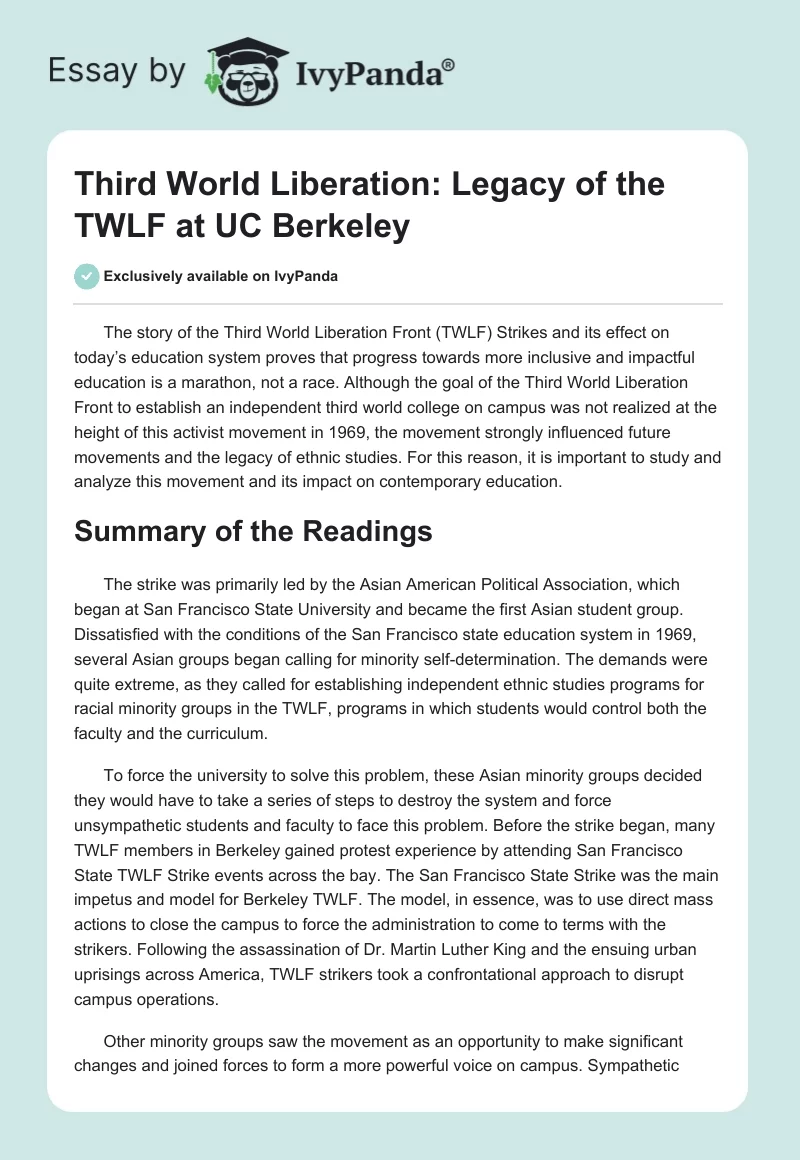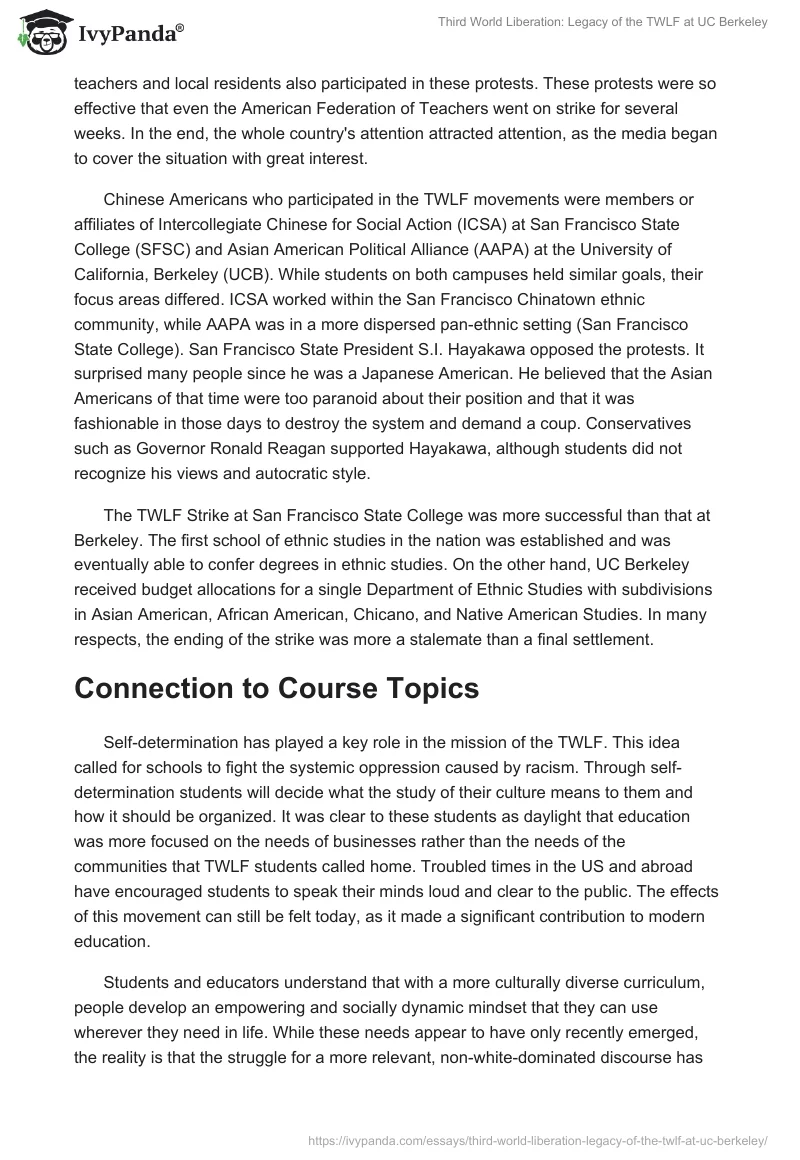The story of the Third World Liberation Front (TWLF) Strikes and its effect on today’s education system proves that progress towards more inclusive and impactful education is a marathon, not a race. Although the goal of the Third World Liberation Front to establish an independent third world college on campus was not realized at the height of this activist movement in 1969, the movement strongly influenced future movements and the legacy of ethnic studies. For this reason, it is important to study and analyze this movement and its impact on contemporary education.
Summary of the Readings
The strike was primarily led by the Asian American Political Association, which began at San Francisco State University and became the first Asian student group. Dissatisfied with the conditions of the San Francisco state education system in 1969, several Asian groups began calling for minority self-determination. The demands were quite extreme, as they called for establishing independent ethnic studies programs for racial minority groups in the TWLF, programs in which students would control both the faculty and the curriculum.
To force the university to solve this problem, these Asian minority groups decided they would have to take a series of steps to destroy the system and force unsympathetic students and faculty to face this problem. Before the strike began, many TWLF members in Berkeley gained protest experience by attending San Francisco State TWLF Strike events across the bay. The San Francisco State Strike was the main impetus and model for Berkeley TWLF. The model, in essence, was to use direct mass actions to close the campus to force the administration to come to terms with the strikers. Following the assassination of Dr. Martin Luther King and the ensuing urban uprisings across America, TWLF strikers took a confrontational approach to disrupt campus operations.
Other minority groups saw the movement as an opportunity to make significant changes and joined forces to form a more powerful voice on campus. Sympathetic teachers and local residents also participated in these protests. These protests were so effective that even the American Federation of Teachers went on strike for several weeks. In the end, the whole country’s attention attracted attention, as the media began to cover the situation with great interest.
Chinese Americans who participated in the TWLF movements were members or affiliates of Intercollegiate Chinese for Social Action (ICSA) at San Francisco State College (SFSC) and Asian American Political Alliance (AAPA) at the University of California, Berkeley (UCB). While students on both campuses held similar goals, their focus areas differed. ICSA worked within the San Francisco Chinatown ethnic community, while AAPA was in a more dispersed pan-ethnic setting (San Francisco State College). San Francisco State President S.I. Hayakawa opposed the protests. It surprised many people since he was a Japanese American. He believed that the Asian Americans of that time were too paranoid about their position and that it was fashionable in those days to destroy the system and demand a coup. Conservatives such as Governor Ronald Reagan supported Hayakawa, although students did not recognize his views and autocratic style.
The TWLF Strike at San Francisco State College was more successful than that at Berkeley. The first school of ethnic studies in the nation was established and was eventually able to confer degrees in ethnic studies. On the other hand, UC Berkeley received budget allocations for a single Department of Ethnic Studies with subdivisions in Asian American, African American, Chicano, and Native American Studies. In many respects, the ending of the strike was more a stalemate than a final settlement.
Connection to Course Topics
Self-determination has played a key role in the mission of the TWLF. This idea called for schools to fight the systemic oppression caused by racism. Through self-determination students will decide what the study of their culture means to them and how it should be organized. It was clear to these students as daylight that education was more focused on the needs of businesses rather than the needs of the communities that TWLF students called home. Troubled times in the US and abroad have encouraged students to speak their minds loud and clear to the public. The effects of this movement can still be felt today, as it made a significant contribution to modern education.
Students and educators understand that with a more culturally diverse curriculum, people develop an empowering and socially dynamic mindset that they can use wherever they need in life. While these needs appear to have only recently emerged, the reality is that the struggle for a more relevant, non-white-dominated discourse has been going on in schools for decades. Proponents of ethnic studies consider the strikes of the Third World Liberation Front one of the first key events in this struggle. Multiracial solidarity was established by bringing together African American, Asian American, Native American, and Chicano students to form the Third World Liberation Front (TWLF) with the support of white student allies (Dong, 2020). The strike then changed academia, and its legacy influences how we look at history and social transformation today. In many ways, the TWLF and the resulting solidarity have allowed future generations to learn from the past to change the present.
Response to the Reading
The topic is exciting and close to me because I believe deeply in change and upheaval. It stimulates any society that becomes stagnant in daily life. People often do not notice or think about what minorities may experience and feel. Often they do this not intentionally but simply out of ignorance or unwillingness to know. Such movements give impetus to the development of society, draw attention to acute problems and really help to solve the problems of inequality. It is a long and complex process that cannot be solved after several years of protests. It sometimes picks up speed, then slows down, but it should never stop. If this process stops, then society has stopped developing and getting better, and regression most often begins when there is no progress.
The 1968 and 1969 World Strike in San Francisco has a special status for me. This event was important because it gave people the understanding that they could unite despite ethnic differences, garner the support of other minority groups and sympathizers, grab national attention, and motivate the institutional unit to respond. I learned about this event before, but I was amazed to see that the Third World Liberation Group had enough influence to force the unwilling status quo to confront the issue. I was delighted that these people took control of the situation without being silent, without letting the system stop them from believing in what they were doing. I believe that it is essential for everyone to know their history, even if it has nothing to do with their skin color or ethnicity: since events such as this strike affected us much more than we may think.
These strikes, taking place throughout history on college campuses, demonstrate the strength of solidarity and the power of students from different minorities. The message of the TWLF is that institutions will not oppress and silence people of color and will not take away students’ right to education. The impact of this powerful message and student struggles at the time can still be seen on campuses and educational opportunities for minority students today.
Reference
Dong, H. (2020). Power of the people won’t stop: legacy of the TWLF at UC Berkeley. Eastwind Books of Berkeley.
San Francisco State College. The Strike Explained. SF State College Strike Collection.


